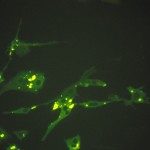Lien vers Pubmed [PMID] – 18190679
Virol. J. 2008;5:4
Hantavirus genome sequences were recovered from tissue samples of Myodes rufocanus, Microtus fortis and Microtus oeconomus captured in the Baikal area of Buryatia, Russian Federation. Genetic analysis of S- and M-segment sequences of Buryatian hantavirus strains showed that Myodes-associated strains belong to Hokkaido virus (HOKV) type while Microtus-associated strains belong to Vladivostok virus (VLAV) type. On phylogenetic trees Buryatian HOKV strains were clustered together with M. rufocanus- originated strains from Japan, China and Far-East Russia (Primorsky region). Buryatian Microtus- originated strains shared a common recent ancestor with M. fortis- originated VLAV strain from Far-East Russia (Vladivostok area). Our data (i) confirm that M. rufocanus carries a hantavirus which is similar to but distinct from both Puumala virus carried by M. glareolus and Muju virus associated with M. regulus, (ii) confirm that M. fortis is the natural host for VLAV, and (iii) suggest M. oeconomus as an alternative host for VLAV.

